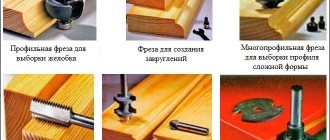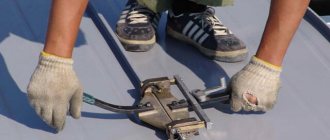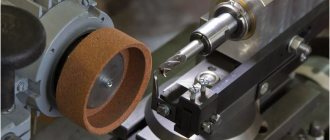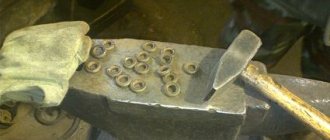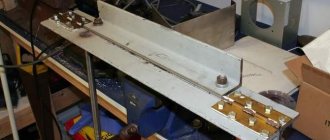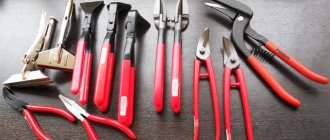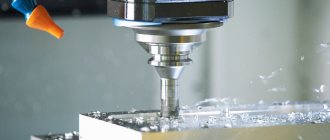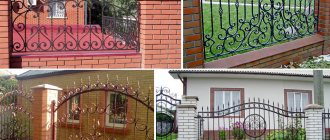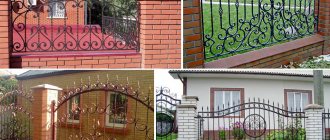Preparing for work
In creating beautiful wooden products, it is of great importance to take practical lessons in working with a hand router. You should start with light models and simple operations. It is more convenient to work with a submersible type tool that has columns directed perpendicular to the sole. The housing with the engine and the tool is lowered along them. They make it much easier to adjust the depth of cut and require less effort to control the tool.
First, you should learn how a manual wood router works. A motor is installed in the housing. The rotating moment is transmitted to the spindle and directly to the tool secured by the collet. The manual wood milling machine rests on the sole. It has a window opposite the spindle through which the tool is lowered into the working area. There are notches opposite the cutter axis. The operator is guided by them during manual cutting along the markings.
Milling of wood is carried out by rotating a cutter secured by a collet in the spindle. The tool is manually guided along the marking line or templates and special devices are used to create a beautiful cutting line.
Craftsmen note the wide capabilities of a wood milling machine. The main operations it performs:
- drilling holes;
- sampling of quarters;
- milling of grooves, splines;
- creating spikes of various shapes;
- alignment of side surfaces;
- adjustment of seats;
- edge profiling;
- cutting discs of various sizes;
- decorative wood carving.
Craftsmen independently create devices and increase the number of operations performed with a manual wood milling machine.
Selecting the right equipment
A manual milling machine is selected according to the type of work and the planned load. There are main types of equipment for woodworking:
- vertical – top type;
- lamellar;
- edge
Horizontal lamellar router. A disk with teeth along the edge moves parallel to the sole and cuts grooves in the side surface for flat keys in the mating parts without marking. The use of the tool is narrow. The lamellar type of tool is in demand in the production of furniture and building wooden structures. It is rarely purchased for a home workshop if the owner is seriously interested in making furniture and has models of universal hand routers available.
The edge router is designed to give a beautiful look and complex shape to the ends of the board. Lateral processing of parts with complex configurations is possible if templates and cutters with bearings are used.
The top type router is universal for wood processing. It is he who is capable of performing almost all operations. Its kit includes several devices that allow you to process the ends and work along the plane of the board. Basically this is a parallel fence with rods, milling bushings and a set of cutters of various types. The former guide the machine exactly along a straight cutting line or help make an even circle. The bushings guide the machine along the template, repeating its shape of any complexity.
To make grooves, cuts for locks and canopies, and create beautiful edges of any configuration in wood, a top-type router is suitable.
Tools and machines for metal milling
As you know, the purpose of milling is to obtain parts of the desired shape from metal blanks and with a certain surface cleanliness. To produce a product that fully complies with the design documentation, you need a certain type of machine and a competent choice of cutters.
Main types of cutters
Today, the Russian market offers cutters of domestic and imported production, of various types and designs, with cutting edges made of modern alloys, ceramics, carded wire, and diamond-coated steel. This diversity makes it possible to perform milling work in areas where metal sampling with complex geometry and high requirements for surface quality is required.
The classification of cutters involves their division according to the following parameters:
- by design (one-piece or prefabricated);
- by the location of the teeth and cutting edges;
- by the direction and design of the teeth;
- according to the material of the cutting elements;
- according to the method of fastening the cutting elements.
Disc cutters
Disc cutters are used for milling work if it is necessary to trim workpieces, remove metal, cut grooves, and chamfer. The cutting elements of disk cutters can be located on both or one of the sides. The choice of cutter size and its teeth depends on the type of processing (preliminary, intermediate, finishing). The advantage of disc cutters is their ability to work with significant vibrations and the absence of the need to remove chips from the cutting area.
End mills
Face mills perform milling of parts with stepped and flat surfaces. The axis of rotation of the medium is perpendicular to the plane being processed; the working part is the end part. Solid face mills often use indexable inserts. Milling cutters with a large number of teeth do not interfere with the smooth operation of the machine and make it possible to process parts at high speed.
Cylindrical cutters
Milling cutters of this type are divided into two groups: with screw teeth and with straight teeth. The former are distinguished by smooth operation and versatility of use; in case of high forces, twin cutters with multi-directional teeth are required. The latter are used for milling narrow planes. Cutting grooves and processing ledges is carried out using rasp cylindrical cutters.
Angle cutters
Angle cutters are designed for milling corner grooves and chip flutes, as well as for processing inclined surfaces. There are single-angled ones with the cutting edge located on one conical surface and double-angled ones with the cutting edge on two adjacent conical surfaces. Grooves with beveled side surfaces are milled with single-angle dovetail cutters - simple or inverted.
End (finger) milling cutters
Such tools can be used to produce contour recesses and ledges, make grooves, and mill mutually perpendicular planes. Spherical recesses are milled with ball cutters, radius cutters are used to obtain complex-shaped grooves, and for T-shaped grooves, respectively, mushroom cutters are used. End mills are divided into groups according to the shape of the shank, the size of the teeth and the design.
A special group consists of engraving cutters (engravers), used for fine processing of materials, including precious metals. And finally, carbide cutters: they allow milling of metals, the processing of which is difficult due to the structure of the material - cast iron, tool steels, etc.
Shaping cutters
These cutters are designed for processing shaped surfaces. They are used for milling parts whose length is several times greater than their width. There are shaped milling tools with pointed and backed teeth. Sharpening the latter is associated with significant difficulties and requires skill and experience.
Hobs
Milling of metal workpieces with a hob tool is carried out using the rolling method, which involves point contact of the part with the cutter. Hob cutters are usually divided into subtypes according to the following parameters:
- by design (prefabricated or solid);
- in the direction of the turns (right or left);
- by the number of spirals (single- and multi-thread);
- according to the characteristics of the teeth (with ground and unground teeth).
Annular cutters
Annular cutters are used to make holes and resemble core drills in configuration. Milling with this tool gives a time gain of approximately 4 times compared to drilling due to the high cutting speed.
Milling machines
Metal processing by milling is performed on special milling machines. They all have a similar operating principle, but differ in design and functionality.
Vertical milling machines
This type of machine can be used for cutting grooves and corners, processing gears, horizontal and vertical surfaces, and frame elements. Milling is performed with shaped, cylindrical and end mills.
Horizontal milling machines
The equipment of this milling group makes it possible to perform milling work on parts with small overall dimensions. In this case, end, shaped, face, corner and cylindrical cutters can be used.
Universal machines
In universal machines, the console and work table can move along guides - vertical and horizontal, and the surface to be processed can be set at the desired angle (relative to the spindle). This type of machine allows you to use any type of cutters and produce milling parts of the most complex configuration.
Cutter selection
Depending on the type of processing, various wood cutters are used for a hand router; there is a wide choice:
- cylindrical;
- disk;
- end;
- conical;
- folded;
- fillets;
- moulding;
- profile.
Cylindrical cutters for wood processing create grooves and cuts of various configurations. They are used for cutting parts, creating blind and through holes. With their help, tongue-and-groove joints are made on the mating parts with exact matching sizes and configurations.
The easiest way to cut a groove with a manual wood router is to use a disk cutter. The tool is selected in width equal to the thickness of the key. Grooves of any length are cut in one pass. The distance to the plane is adjusted by the sole and stops. On a lamellar machine for processing wood, the angle of inclination, distance from the end and height are set using stops on the sole and automatically, without marking, an exact match of the grooves for the key is ensured. The assembly of mating parts is carried out without displacement or distortion.
Specialists who know how to work with each type of cutter and what templates to make make the complex dovetail joint using hand-held equipment.
When figuring out which cutters can do what when processing wood, you should pay attention to the shape of the cutting edge. In a rebated one, it is wide and even. In one pass with low feed, you can select a quarter. The disk one can do this job in 2 moves. It must be rearranged after the first cut at a right angle. But rebate cutters for wood processing transform everything into chips. After the disk, square slats remain, suitable for use.
Fillet, molding and profile cutters are all shaped cutters. When carving wood with a router with your own hands, the end takes on a shape opposite to the configuration of the cutting edge. The fillet chooses a quarter radial shape. A moulder with an oppositely shaped cutting edge makes a beautiful radius instead of an angle.
Electric milling machines with complex configurations are used for the manufacture of skirting boards and baguettes, carved edging for cabinet furniture.
In a home workshop, cutters for a beginning carpenter should be simple in shape and small in diameter. They experience less wood resistance during processing. The router is easier to control. After mastering simple operations of cutting grooves and cutting out straight parts, you can move on to complex woodworking techniques.
Devices for installing workpieces on milling machines
When performing universal work related to milling planes, workpieces are installed on a milling machine in three main ways: in a vice, on the machine table, on corner plates.
Relatively small workpieces are secured in a vice. Large workpieces (such as plates, housings) are placed on the machine table. To strengthen large workpieces, the processed surfaces of which must be located at a certain angle to each other, corner plates are used.
Milling fixtures
To install and secure workpieces on the machine when milling planes, general-purpose milling devices are used: machine vices, clamps, clamps, stops, corner plates.
machine vices are divided into fixed, rotary and universal; according to the method of operation - with manual and mechanized drive; in terms of accuracy - normal class N and increased - class P.
A fixed vice consists of a body with a fixed jaw and a movable one.
The latter is installed on rectangular housing guides and connected to them by straps. It is driven manually by rotating a handle placed on the square of the screw. Attached to the vise jaws are steel hardened overhead jaws with a corrugated or smooth working surface, designed for securing workpieces. Guide keys are used to align the vice on the machine.
Rotary vices differ from non-rotating ones by the presence of a base with a degree scale.
Thanks to this, the body of such a vice can be rotated to the required angle and secured with bolts and nuts. The universal vice is characterized by the ability to rotate the body in two planes - horizontal and vertical. Therefore, they are used when milling inclined planes and bevels located in different directions. A mechanized vice with a pneumatic or hydraulic drive significantly reduces the physical load of the milling operator and increases labor productivity.
In a vice with a piston pneumatic drive, compressed air from the workshop network enters through a fitting into either the right or left cavities of the pneumatic cylinder (depending on the position of the distribution valve handle). In this case, the piston together with the rod, screw, nut and movable jaw will move progressively left or right, clamping or pressing the workpiece. The screw and nut are used to install the required jaw solution depending on the dimensions of the workpiece being fixed.
Machine vices can be equipped with wedge-type or special profile jaws.
Wedge jaws are made of two wedge-shaped parts connected with a certain degree of freedom with screws. The part is fixedly attached to the vise jaw with screws, and the part is constantly pressed upward by spring-loaded pins. When the parts of the overhead jaw come into contact along an inclined plane, the workpiece is simultaneously pressed against the stationary jaw and against the guides of the vice body.
Overhead jaws of a special profile expand the technological capabilities of machine vices.
Clamps are the simplest clamping devices that are used primarily for securing large-sized workpieces directly on the milling machine table or on corner plates. They can be divided into three main groups: tiled, fork-shaped, trough-shaped.
Stops and clamps are used in cases where it is necessary to use lateral fastening of the workpiece on the machine table. The workpiece is secured using a stop and a wedge clamp.
The workpiece on the left rests on a stop, which is correctly oriented along the table groove with a projection and secured with a bolt and nut. On the right, the workpiece is clamped with a clamp consisting of a wedge with an oblong hole for a bolt and a base with a protrusion that fits into the groove of the table.
The base is attached to the machine table with a bolt and nut. When screwing the nut, the wedge, sliding along an inclined plane, simultaneously presses the workpiece against the stop and the working surface of the machine table.
corner slabs are divided into simple, rotary and universal.
A simple corner slab has the shape of a square with mutually perpendicular flanges and stiffeners. The horizontal shelf has lugs for fastening the plate to the machine table, and the vertical shelf has elongated grooves through which bolts are passed when securing the workpiece with clamps.
A rotating corner plate differs from a simple one in that its vertical shelf can be rotated around its axis to the required angle on the scale and secured with a nut.
The universal corner plate allows you to rotate the workpiece in two planes - horizontal and vertical. This stove consists of three main parts: the base, the body and the semicircular table. The housing can be rotated relative to the base in a horizontal plane and secured with bolts and nuts.
The table is rotated in a vertical plane by a worm gear when the handle is rotated and is fixed in the required position after tightening the nuts. Angular turns are counted using degree scales. On the side of the working surface of the table there are T-shaped grooves, allowing workpieces to be secured on it with clamps or using other fastening devices.
The principle of operation of a manual milling cutter
To learn how to work with a wood router, you need to master the selection of basic cutting options and choose the right operating parameters. Milling lessons include:
- characteristics of wood of different species;
- choosing the type of equipment depending on the volume of work;
- correct selection of tools;
- setting cutting depth in one pass;
- speed adjustment.
The first operations must be performed on a small router. It is light, low-speed. It is easy to hold in your hands and guide along the markings. For beginning carpenters, it is better to learn on birch, aspen, and poplar. The wood is relatively soft, not resinous. Wood processing is easy and smooth. The cutting modes along and across the fiber differ little.
Rotation speed selection
The cleanliness of wood processing largely depends on the speed of rotation of the cutting edges. The larger it is, the smoother the surface will be. Beginners should not start with high speeds and feed of the machine. The milling cutter requires some skill. When working, you have to use force to hold it and direct it where it should be.
The manual router is adjusted using the adjusting knobs on the body. The choice is made based on the material, depth of cut and cutter diameter. Rotation speed of light models from 7000 rpm. Professional high-power handheld equipment can reach 24,000 rpm. Smooth adjustment is made with a round knob mounted on the body near the motor. Minimum speeds are used when engraving and working with large-diameter tools or milling to great depths. Light models cannot withstand prolonged use at maximum speed.
The cut along the fiber is cleaner; you can set the average value for the number of revolutions. Cross cutting chips the edges. Maximum speed is suitable for it. In this case, you should reduce the feed - the speed of movement of the cutter. The table shows the dependence of feed on load - tool radius at medium speed.
| Cutter diameter, mm | Cutting speed, mm/sec |
| 4 — 10 | 5 — 7 |
| 12 — 20 | 3 — 6 |
| 22 — 40 | 1 — 3 |
When processing pine and birch, the feed rate is selected according to a larger value. Considering the hardness of oak, beech, and walnut, you should move the tool slowly.
If you have a choice, you should purchase equipment with a soft start function. Otherwise, you need to turn on the engine idle and then start working smoothly.
Securing the cutter
During the work process, the need to change the cutter constantly arises. It is more convenient to do this if you place the router on its side or place it on the top cover.
- Enable spindle lock. If the tool does not have such a function, unplug it and hold the spindle with a key.
- Unscrew the collet nut.
- Pull out the tool.
- Insert the cutter with the shank into the collet and tighten the nut.
- When working on a copier, install a copy sleeve.
- Turn it on and check at low speeds that there is no runout.
- Turn the router over and adjust the height of the cutter edge.
You can continue working. When replacing a tool, you must check whether it has a suitable diameter for the hole in the base of the tool.
Setting the milling depth
When cutting grooves and other operations, the milling depth must be precisely adjusted. For this purpose, there is a lift on the side of the case - a screw with a graduation scale. In professional models there are two of them, coarse and fine settings. This allows you to set the cutting depth with an accuracy of 0.01 mm.
First, the milling machine is placed on the sole and a zero value is set relative to the surface of the part. Then the elevator sets the desired cutting depth.
Common Techniques
A plunge router is a versatile piece of equipment that can perform a variety of operations. When working with equipment, the following techniques are used:
- leveling the surface;
- selection of grooves;
- edge milling;
- work according to the template.
Most often, in home workshops and enterprises, grooves are cut with a hand router. Depending on the location and shape, cylindrical and disk cutters are used. Their diameter and width correspond to the size of the key. Various devices are used for precise milling along markings.
When making any wood products, it is necessary to process the edges of the parts: leveling and giving a complex shaped shape. You can also mill the edge with a filler mill. The tool runs along the end, resting against the template with a bearing or rod. It cuts the side to size and creates a beautiful edge.
The most common technique is to work with a hand router using a template. The copying sleeve slides along the edge of the stencil, keeping the tool within its line.
Techniques for working with the template greatly simplify the implementation:
- keyways;
- curly cutouts;
- cutting parts;
- trim;
- decorative elements.
The template can be made from any material that is easy to cut: plywood, plexiglass, plastic. The cutout in the stencil is made larger; it is increased in each direction by the difference between the radii of the sleeve and the cutter.
Metal milling: methods and types
The movement of the cutting tool relative to the part can be achieved due to the translational movement of the rotating cutter itself or the gradual feeding of the workpiece - this depends on the design of the machine. Depending on the thickness of the cut layer, the characteristics of the metal and the desired surface quality, milling the workpiece can be carried out in one or several passes. These same factors influence the determination of the optimal feed rate.
Regardless of the characteristics of the metal and the type of machine for milling the part, the cutting speed V and the feed speed of the part S are determined. Both parameters have the dimension m/min. The cutting speed V is calculated by the formula V=π*D*n, where π is the Pi number (3.14), n is the rotation speed of the cutter, D is its diameter.
Milling methods
There are two ways to process parts on milling machines:
- counter;
- passing.
In the first case, the direction of movement of the workpiece coincides with the direction of movement of the cutter. In the second, the cutter moves towards the fed workpiece. The difference between them lies in the quality of the resulting surface. If workpieces are milled using a downhill method, the machined surface is smoother. Counter milling produces a less smooth surface, so it is used in cases where it is necessary to remove a large layer of metal. As a rule, this is done during rough milling - if a second pass is planned to achieve the final (finishing) result.
Types of milling parts
Processing a workpiece on milling machines involves performing one of four types of milling or sequential use of several types.
- End milling: used for machining manholes, windows, pockets, splines, grooves, etc. In this case, milling processing is carried out using slot, disk, end, T-shaped, single- and double-angle cutters.
- End milling is used for processing large surfaces. Milling of such parts is carried out using end or cylindrical cutters.
- Shape milling is necessary when working with profiles. To obtain shaped surfaces with the desired geometry, shaped, modular, disk and hob cutters are used.
- Metal cutting (milling of material for the purpose of cutting it) can be performed with cutting cutters, which are like a circular saw.
In metal recycling, reverse classification is also used, the principle of which is to combine cutters according to technological characteristics into groups, each of which is intended for a specific type of processing of parts.
What can be made
What can you do at home with hand tools? The router is universal and can help in the manufacture of furniture and in the construction of a house. In mass production, step-by-step production is used on a highly specialized milling machine. Hand tools are universal, easily reconfigured and replace an entire conveyor of machine tools.
A hand router is used when installing doors. Using a template, grooves for locks are cut out in the canvas, and understatements are made to install the hinges.
Furniture cannot be manufactured without grooves for dowels or tenons on the corresponding parts. This operation is preceded by cutting the board. To make the shelf and large cabinet look beautiful, the edges should be processed with a moulder or figured cutter.
Wood crafts in the form of carved furniture, trim, and frames are popular among those who love to make things at home. During construction and renovation, you can make the panels and baseboards yourself. Recently, tables and window sills made of slabs have become popular. Craftsmen make devices with guides along the table. A transverse carriage runs along them. As a result, small hand-held equipment is used to level and polish huge planes of wooden saw cuts.
